We have used cast iron cookware to cook our food for centuries. And for a good reason, cast iron is durable, healthy, and beautiful. No wonder this rather weighty material has made such a comeback in recent years. But have you heard of Japanese cast iron?
Table Of Contents
- History
- Cookware options
- Popular and trusted Japanese brands
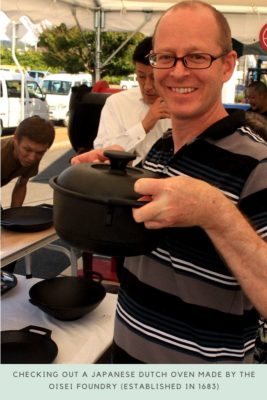
History Of Japanese Cast Iron
Nambu Ironware
During the Edo period (1603-1868), around the end of the 17th century. The Nambu Clan invited artisans from Kyoto in Southern Japan to come to Morioka to make cast iron products, including iron armor, tea kettles, and pots.
During this time, there was almost no trading with the outside world, and the area’s economy relied on the domestic market. Industrial specialization was vital for feudal lords to hold power. The Nambu rulers hoped specializing in ironware would help the area economically. And strengthen their influence both financially and culturally.
Iwate Ironware Became Treasured Gifts And Home To A Cottage Industry.
Iwate ironware became a popular and cherished gift to feudal lords during the Edo period. And the iron kettles became an item of admiration and desire for the masses throughout Japan.
Today, Nambu ironware remains a specialty of the region. The two main areas of cast iron manufacturing, Osu and Morioka, are home to many foundries and artisans. Luckily, Japanese-manufactured cast iron is much more affordable these days.
To learn more about Iwate ironware, check out this article.
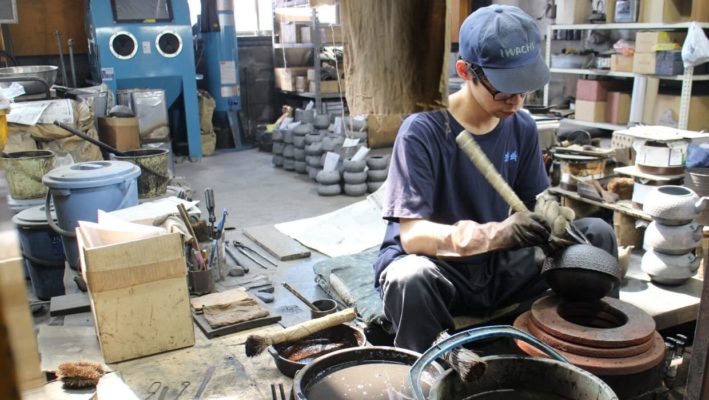
Where Is The Best Japanese Bast Iron Made?
To this day, Iwate manufactures high-quality kettles, teapots, and cookware. With Morioka and Osu home to many foundries. Of which many are small workshops of one or two workers.
Yamagata is also a cast-iron manufacturing hub with a history of hundreds of years. And other regions, such as Aichi and Niigata, have good brands that offer various products.
If you are looking for a Japanese teapot, here are my top choices.
Why Is Japanese Cast Iron Expensive?
Japanese artisans have perfected the art of making cast iron over the last 800 years. Artisans can study for 15 to 40 years to learn how to make Nambu ironware. This dedication shows how much sophistication goes into Japanese cast products. As a result, Japanese cast iron is more expensive than low-cost manufacturing countries.
However, more Japanese companies have switched to sand molding instead of traditional clay molds, resulting in more affordable cookware.
What Kind Of Cast Iron Cookware Is Popular In Japan?
Kettles
Nambu Tetsubins are Japanese cast-iron kettles. Making a traditional clay-molded Tetsubin is a detailed process that usually consists of around 68 steps.
Master craftsmen called kamashi oversee the entire process of making tetsubin. These artisans train for 30 years or longer to learn the craft.
To Make A Tetsubin:
- The artisan carefully etches the pattern into the clay mold.
- Artisans pour molten pig iron or crude iron into an inner mold made of clay or sand.
- Artisans remove the kettle from the mold.
- Workers hammer imperfections out by hand.
- The kettle is then oven-fired to prevent rust.
- Lastly, the craftsman coats the kettle with a lacquer made from a mixture of green tea, brown rust, vinegar, and pine ash.
If you want to learn how to use a cast-iron kettle, click the link to read my easy-to-follow guide.
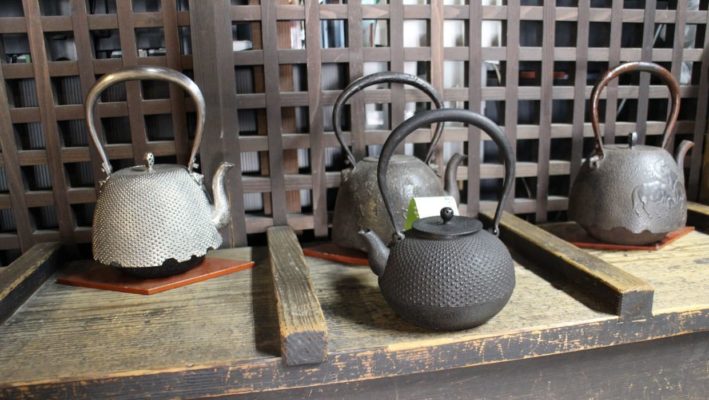
Cast Iron Teapots
Cast iron teapots, called Tetsu Kyūsu in Japan, have an enamel coating on the inside. The enamel helps inhibit rust and makes the teapots easy to clean.
Because of the enamel lining, you cannot use a cast iron teapot on a heating element to boil water, as the lining might get damaged. These types of teapots are for steeping or brewing tea. Most come with a stainless steel infuser that conveniently holds tea leaves and can easily be removed for cleaning.
Teapots are super easy to use, but I’ve written a step-by-step guide if you are interested.
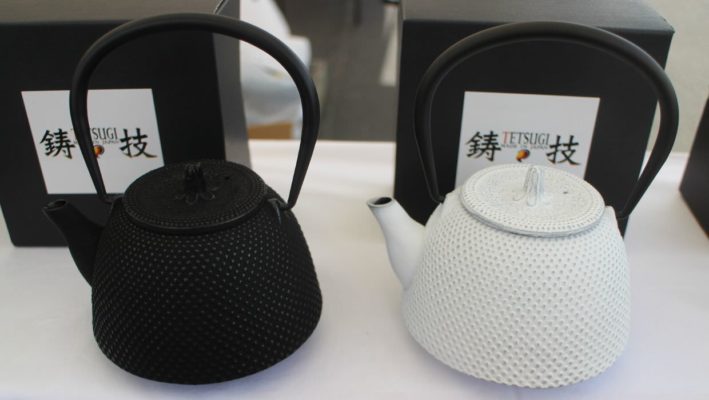
Skillets And Cast Iron Bowls
The use of cast iron bowls in winter remains popular. The Japanese often make seasonal dishes such as Nabe and Sukiyaki in cast iron. However, summer barbecuing is also popular, and an old-fashioned skillet is a good choice.
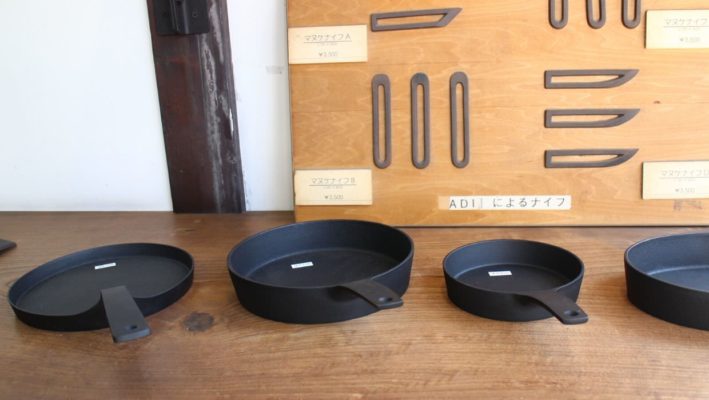
Why Should You Buy Japanese Cast Iron Cookware?
Cast ironware offers a variety of benefits compared to other materials. Here are some of the reasons to purchase Japanese cast iron.
Tetsubin
With modern kettles available, why choose a tetsubin? Here are a few of the reasons
- You can use a tetsubin over an open flame and other heat sources.
- A Japanese tetsubin mineralizes and softens the water.
- Sure, a cast-iron kettle can rust. However, you can restore rusty kettles to almost new with some elbow grease and know-how.
- When you use a cast iron tea kettle to boil water, you get the added benefits of iron supplementation.
Cast Iron Teapots
So, why a cast iron teapot? Here are some reasons:
- Beautiful: It is hard to match the beauty of a cast iron teapot. These feature bright colors and detailed, elaborate designs.
- Durable: Similar to tetsubins, cast iron teapots will last for years. As long as you follow some simple care tips, you can expect to pass them down to your children and even grandchildren.
- Easy to care for: Because of the enamel interior coating, cast iron teapots are relatively easy to use. They are resistant to rust. After using, rinse with warm water and dry thoroughly.
- Superior heat retention: Cast iron teapots stay warm for long periods. Remove the tea strainer from the pot after brewing to prevent over-extraction.
If you don’t know the difference between a teapot and a kettle, check out this article.
Cast Iron Cookware
There is no substitute for cast iron cookware. If you have just one pan in your kitchen, it should be a cast-iron skillet. Cast iron produces perfect sear without burning. If that is not enough to convince you, here are a few more benefits of cast iron cookware.
- Versatile: You can use the same cast-iron skillet to fry eggs, cook over the campfire, and bake your favorite dessert.
- Durable: When you invest in a cast-iron skillet or Dutch oven, you are investing in a piece of cookware that can last your entire lifetime.
- Gets better with age: With a natural patina or seasoning that forms when you use it, cast iron cookware improves with repeated use. How many other types of cookware can you think of that gets better with age?
Popular Japanese Cast Iron Brands
Vermicular
Most of the Japanese cast iron companies have been in operation for generations. However, many new start-ups often give a modern take on traditional designs. And Vermicular is one of these companies that have come onto the scene.
The company was started in 2010 by two brothers. Already, it has achieved widespread acclaim and has risen to become the equivalent of Le Creuset in Japan.
Sure, the Musui-Kamado is expensive, granted. However, it does an impressive array of things. You could use it to make rice, pasta, meats — just about anything.
It could be the only cookware that you need. Home and professional chefs say it can replace several kitchen tools, including the Instant Pot and the slow cooker. And currently, there is nothing else like it on the market, thanks to the detail that went into making it. And it took the brothers three years to finish the design.
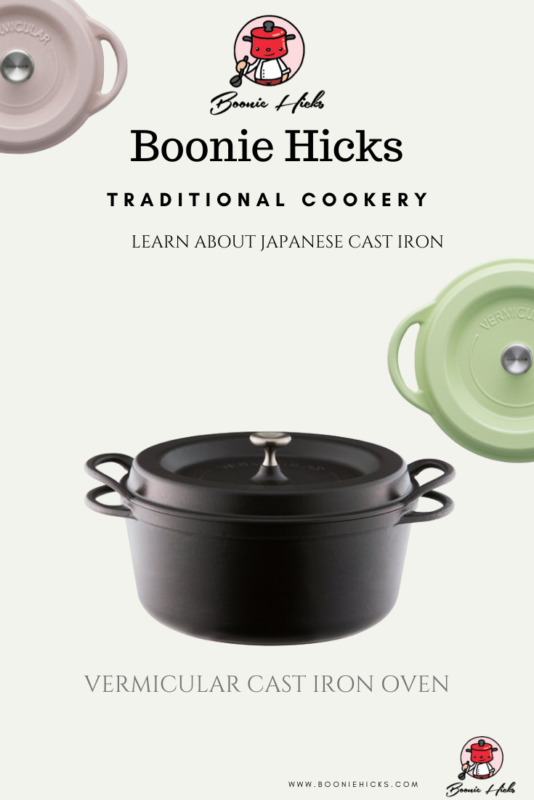
Oigen Cast Iron
Oigen is another well-known Japanese cast ironware company. The foundry is in Osu City, Japan, where Japanese artisans have been casting iron for more than 900 years.
The company has won numerous awards for its cast ironware designs. They sell cast iron products, from camping skillets to wind chimes. They also have a wide range of enameled teapots and traditional kettles available.
I visited the foundry and learned so much about the industry. If you want to learn more about Oigen cast iron, click the link.
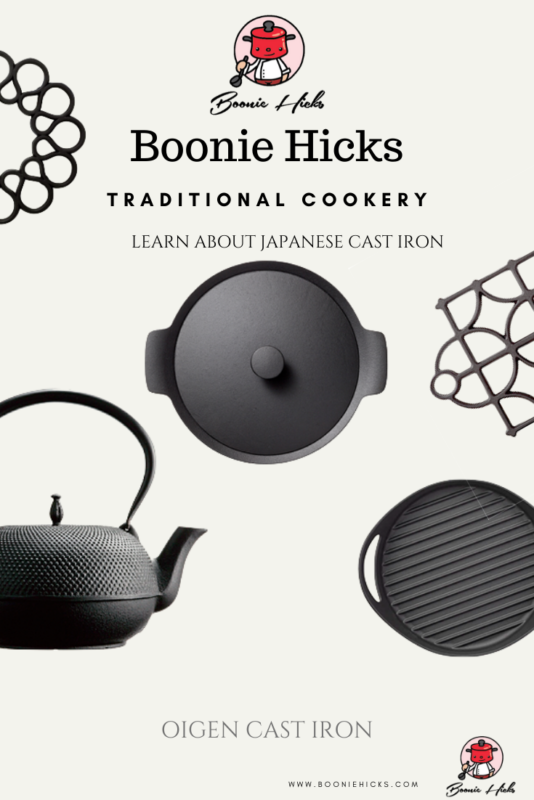
Oitomi
Are you looking for a Japanese iron teapot that will last the test of time? Then you might want to have a look at Oitomi. Oitomi is a family business making cast iron kettles and teapots since 1848. It is another Oshu foundry, an area famous for traditionally made Nambu Tekki and home to many artisans.
To learn more about Oitomi, click the link for an in-house article.
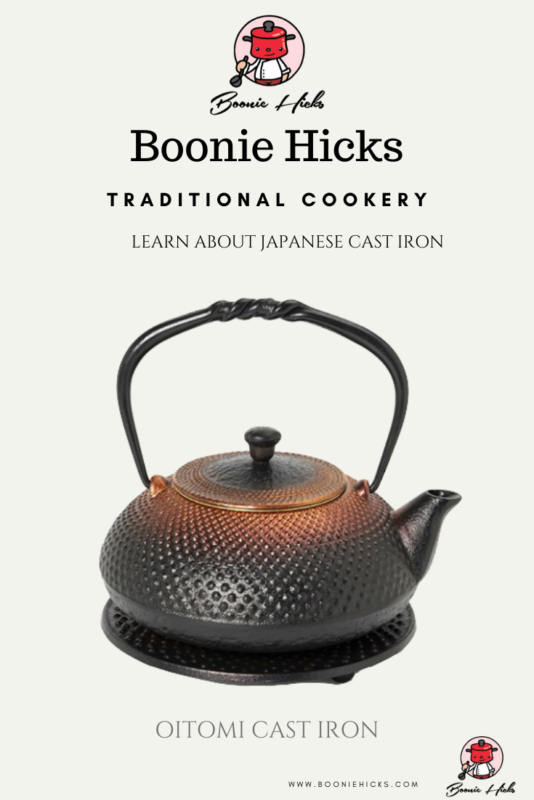
Iwachu Casting Works
Iwachu is one of the leading Japanese cast iron companies. For more than 100 years, the company has produced superior Nambu cast ironware in Morioka, Japan. When you buy traditional Japanese cast iron from Iwachu, you can count on its high quality.
Check out the following link to learn more.
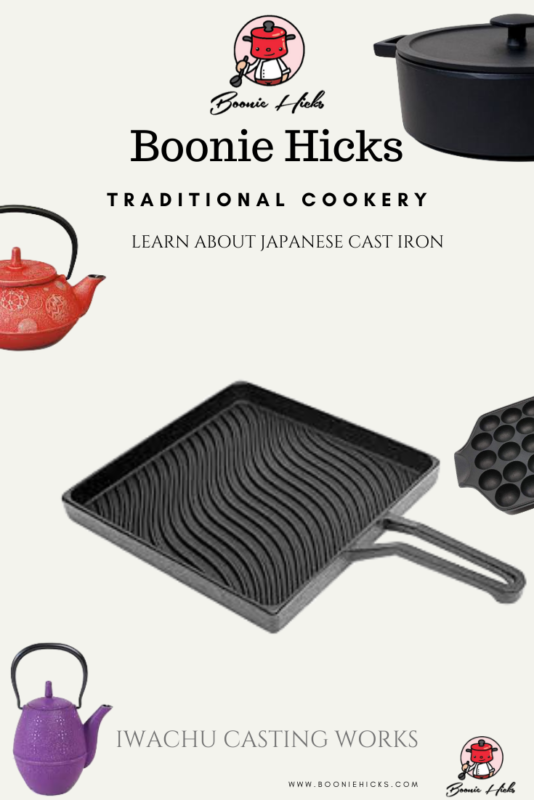
UNILLOY
Unilloy hails from Tsubame Sanjo, Niigata. A manufacturing town known for its many casting works. Unilloy is a new kid on the block, considering the long history of cast iron manufacturing in Japan. And claims to produce some of the lightest enameled cast iron cookware available.
Unilloy is a brand made by Sanjo Special Cast Co., Ltd. The company offers a selection of Dutch ovens and skillets made from FCD (graphite-rich cast iron).
To learn about Unilloy cookware, click the link for an in-house article.
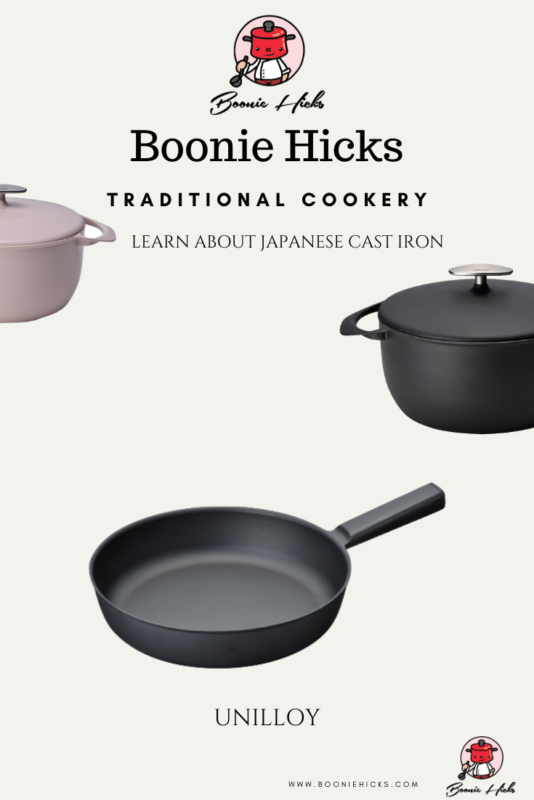
L’hirondelle
L’hirondelle makes some of the finest enameled Dutch ovens and casserole pots I have encountered. They combined superb enameled cookware with heavy gauge stainless steel to protect the edges of the oven and lid.
The small company in Tsubame Niigata outsources its casting locally to Sato-Wax Co., Ltd. Despite the small scale, L’hirondelle is for sale in premium Japanese department stores.
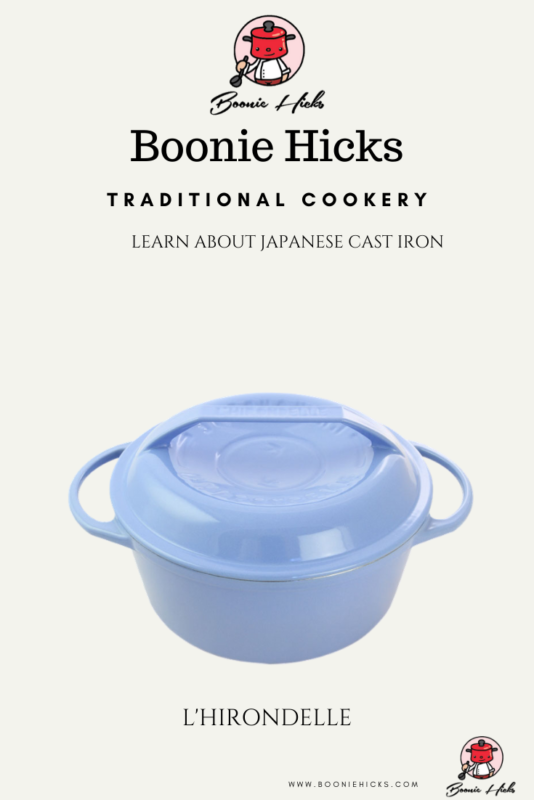
Is Japanese Cast Iron Cookware Worth It?
Authentic Japanese cast ironware is more expensive than other types, but it is worth the money. The detail that goes into making every piece is astonishing. In addition, cast iron offers excellent durability, heat retention, and beauty.

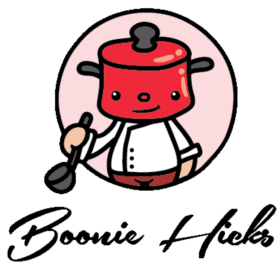
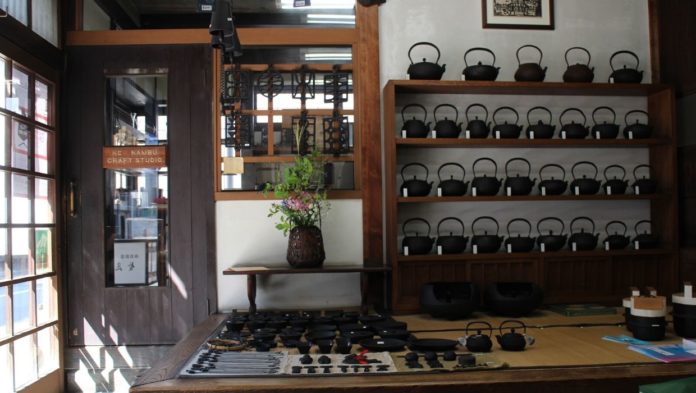
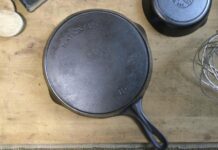
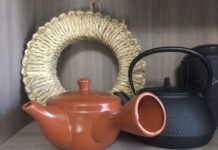
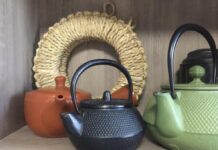



Please send me information re: vintage Japanese cast iron skillets. I just purchased one and would like to know the history behind it. Thank you.
Hi Michelle
I wish it were that easy. Researching, editing, and publishing an article takes me about one week. However, in the 1970s and 1980s, many imports entered the country after they built their manufacturing industries.
I hope you enjoy your skillet; many are fine quality and smooth, just like their American counterparts.
Is there a brand you would recommend for western style cast iron cookware?
I currently live in northern Japan and would like to buy some pieces before heading back stateside.
Hi Fabian
I would recommend Oigen cookware. They have a wide selection of Western and Japanese cookware to choose from. I use a couple of Oigen casserole/braising dishes in my small Japanese apartment. They are heavy, but they will last a lifetime.
Hi Boonie,
Thanks for the reply.
You have a pot from Oisei. I couldn’t find much information about the company. Are they located in Iwate Prefecture?
Also, the picture of the skillets that you show, are they from Oigen?
Sorry for all the questions.
Thanks again,
Fabian
You’re right. Unfortunately, there is little information on the Oisei. The company’s foundry is located in Oshu Iwate, and it’s huge. I believe they mainly manufacture ironware for heavy industry, and it’s reflected in the weight of my Dutch oven.
The skillets are from a small workshop called Kamasada. It’s walking distance from Morioka station if you get a chance to visit. Kamasada is a small family business with a store in the front, and the workshop in the back.
I have a Kamasada shallow skillet and it’s a beautiful pan. It’s thinly cast and has good balance.
And it would a very good choice for a traditional Japanese souvenir.